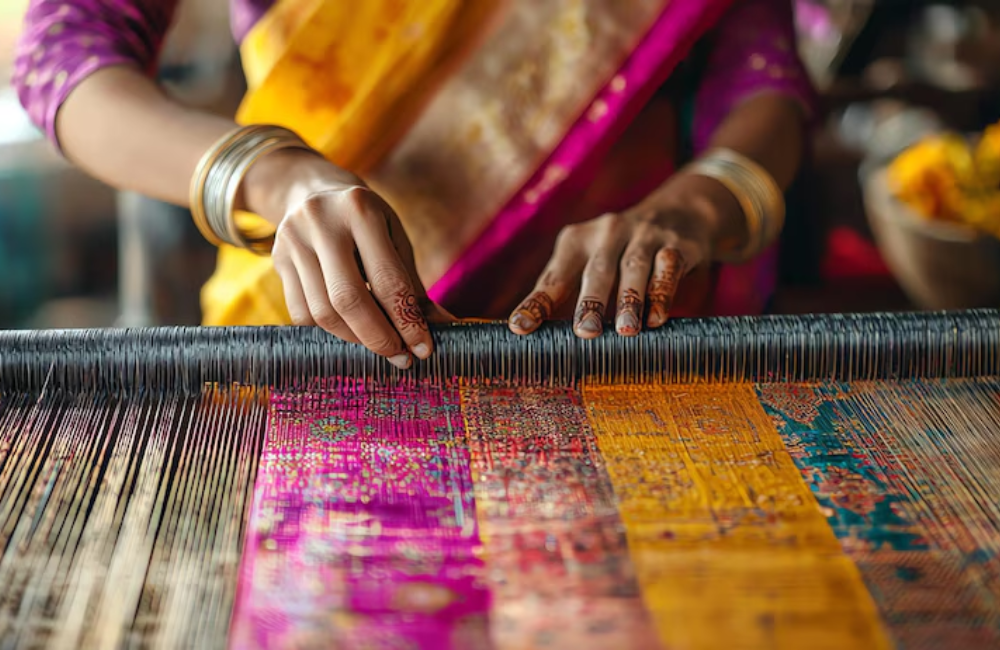Since the day power looms came into effect in Indian textile industry, it was embraced with open arms due to their efficiency and lower costs.
However, this was a huge blow to the handloom industry, as it led to a sharp decline in demand for handwoven fabrics! Along with the handloom workers facing unemployment and financial hardships, the skills and the craftsmanship, which were passed on to generations, started to gradually fade away.
Amidst the rising environmental concerns due to the high-energy consumption ofthe power looms and its not so rich quality, the handloom industry has witnessed a resurgence in recent years. Consumers across the world are increasingly becoming aware of the negative impact that fast fashion has on the environment, and are seeking sustainable alternatives.
So, let’s explore how handloom has been successful in redefining sustainable fashion, and why is there a sudden surge in the demand for Bengal handloom sarees in Kolkata.
Handloom & Sustainable Fashion- A Match Made in Heaven
- The Use Of Natural Fibres
Among the many positives of the handloom industry, the one that stands out is its usage of natural fibres. The handloom industry derives its raw materials from cotton, silk, and linen to manufacture textiles.
What’s the catch in this? Well, natural fibres make these materials highly biodegradable. Hence, it has much less environmental impact when compared to polyester or nylon that are derived from crude oil, and take years to decompose, leaving behind massive carbon footprints.
- The Use Of Plant-Based Dyes
Instead of using synthetic dyes that contain harsh and toxic chemicals, handloom weavers depend on natural plant-based dyes. Although this increases the price tag of handloom cotton sarees online significantly, these natural dyes don’t discharge toxins, unlike their synthetic counterparts, causing massive water and air pollution.
Therefore, even with a slightly higher price tag, choosing handloom sarees is a conscious way to support sustainable fashion practices that aim to protect our environment.
- A Significant Reduction In Carbon Footprint
When compared to the power loom industry which is totally dependent on machinery, the handloom industry relies heavily on manual skills.
How does this help? Well, this heavy reliance on manual labour means that the industry uses far less energy in contrast to power looms where machines do the manufacturing part! This ultimately results in much less use of electricity, or fossil fuels, which causes a significant reduction in carbon footprint!
- Support And Encouragement To Local Economies
A majority of the handloom Bengal cotton sarees online come from small-scale artisans nestled in rural areas. The only thing that keeps these artisans going is their master craftsmanship in exchange for which they expect a fair price.
So, the moment a consumer chooses to buy a handloom product, they extend their support directly to these talented weavers. This support, as little as it might seem on a smaller scale, helps provide these artisans with a fair income, thereby preserving their livelihoods.
Hence, in addition to bolstering the local economy, this practice also helps ensure that the invaluable skills of master craftsmanship continue to be passed down to generations to preserve the tradition of rich cultural heritage.
- Encouraging Longevity Over Mass Production
Handloom weavers have a deep understanding of their craft, which allows them to create products that are both aesthetically pleasing, and long-lasting.
However, being a procedure of a manual-intensive nature, the manufacturing process is quite slow-paced. This is because of the meticulousness of the weavers which results in the production of one-of-a-kind pieces that successfully resist the fast-fashion cycle.
Hence, investing in a Jamdani saree online isn’t all for the garment itself! Instead, a customer is investing his/ her money behind a craftsmanship that lasts for years. This helps encourage a shift towards valuing fewer, and higher-quality items, which helps reduce waste and promotes sustainability.
How Does the Future of the Handloom Industry Look Like?
Well, even after the dominance of fast-fashion products, the growing awareness among consumers is gradually causing a shift in taste because of the growing trends for sustainable and ethical fashion.
Other than that, the government has launched The National Handloom Development Programme (NDHP) which aims to rejuvenate the handloom industry in India by extending their support to weavers and artisans across the country. This programme focuses on the promotion of handloom products through direct marketing channels, which includes e-commerce partnerships as well. This approach helps weavers connect with online platforms to expand their market reach and increase sales volume.
On top of that, the NDHP also has emphasized initiatives like campaigns, e-marketing training, and global collaborations for further promotion of handloom products. This is the reason why newly launched Kolkata saree boutiques have an extensive collection of handloom sarees, showcasing the rich heritage and diversity of Indian textiles. And we at Katha: A Tale of Weaves are no exception!



